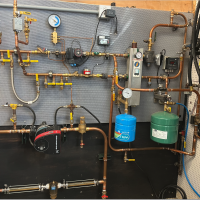Best Of
Re: Identify boiler
…..as is Crown, but I think you once mentioned that they are a rebranded Dunkirk.
Re: House heats up but thermostat is turned off AND thermostat's battery is dead
Did you put C1 back and remove the thermostat wires from TT?
If you have the L8148C, the Lo is to maintain temperature for the coil. It alone won't cause the heat to come on.
If you disconnect the wires from TT and the circulator shuts off, the problem is between TT and the thermostat. If the circulator stays on, it's a bad relay in the aquastat.
 HVACNUT
HVACNUT
Re: Boiler Pressure
It's no wonder HOs don't like contractors.
Paying a price even an exorbitant one can be debated when the job is fixed right.
Getting scalped by a no nothing company or technician is more like fraud especially when it is a simple problem.
Re: dealing with twists in the pex , not staple up. I have Omega extrusions now. YAY!
I would consider mechanically, what a screw does that a staple can't. The time to turn in 6000 screws is nothing compared to the effective heating over the lifespan of the system. Don't be time wise and heating foolish. Ask yourself: "Why did the plate mfg. switch from staples to screws"?
Re: Boiler Pressure
Ah… where are you? Have you checked "Find a Contractor" tab above?
We may know someone…
In the meantime, odds are that it is either your expansion tank or, if there is one, the pressure reducing feed valve…
Re: Here Ye..Here Ye....The Steamfitter's Helper exam.....
You could certainly sit for the exam. NYC loves the fee! Mad Dog
Re: Identify boiler
maybe look under the upper cover, where the electrical box is screwed on
 hot_rod
hot_rod
Re: Vaporstat settings - low pressure vapor system
if they are all gauge pressure they should all be 0 at the same point.



